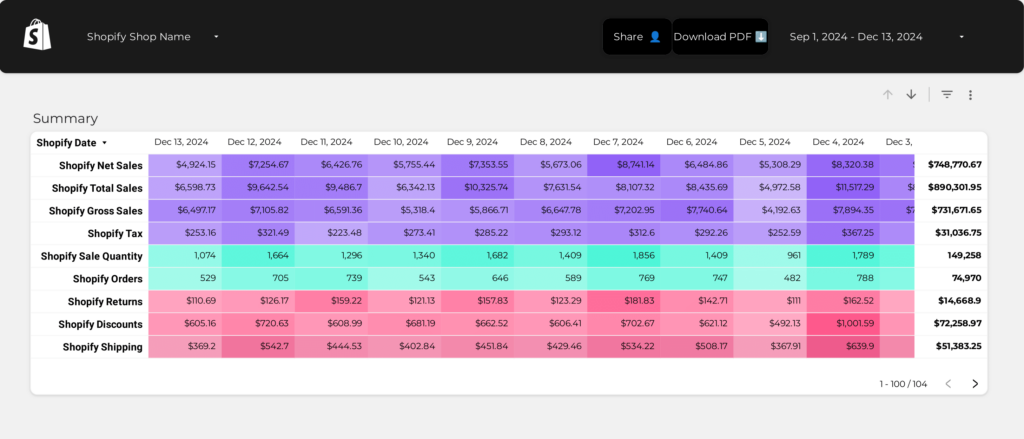A Shopify KPIs report should include the following metrics:
1. Ad Spend
2. Impressions
3. Clicks
4. Conversion Rate
5. Average Order Value
6. Total Sales
7. Customer Lifetime Value
8. Campaign Name
9. Date
10. Product Name
11. Customer Segment
12. Traffic Source
These metrics provide a comprehensive overview of your e-commerce performance on Shopify, helping to track marketing effectiveness, sales performance, and customer behavior.
To analyze Shopify KPIs data, focus on the following key metrics:
1. **Ad Spend**: Evaluate the cost-effectiveness of your advertising by comparing it to revenue generated.
2. **Impressions and Clicks**: Measure the reach and engagement of your marketing efforts.
3. **Conversion Rate**: Calculate the percentage of visitors who make a purchase to assess the effectiveness of your sales funnel.
4. **Average Order Value (AOV)**: Determine the average amount spent per transaction to identify opportunities for upselling or cross-selling.
5. **Total Sales**: Track overall revenue to gauge business growth.
6. **Customer Lifetime Value (CLV)**: Estimate the total revenue expected from a customer over their relationship with your business.
7. **Campaign Name, Date, Product Name, Customer Segment, Traffic Source**: Analyze these dimensions to understand which campaigns, products, and customer segments are most profitable and which traffic sources drive the most sales.
Use these insights to optimize marketing strategies, improve customer targeting, and enhance overall business performance.
To build a Shopify KPIs dashboard, follow these steps:
1. **Identify Key Metrics**: Determine the KPIs you want to track, such as Ad Spend, Impressions, Clicks, Conversion Rate, Average Order Value, Total Sales, Customer Lifetime Value, Campaign Name, Date, Product Name, Customer Segment, and Traffic Source.
2. **Data Collection**: Use Shopify’s built-in analytics or integrate with third-party tools to gather data on these metrics. Ensure data is updated regularly for accuracy.
3. **Choose a Dashboard Tool**: Select a dashboard tool that integrates with Shopify, such as Google Data Studio, Tableau, or a Shopify app like Better Reports.
4. **Design the Dashboard**: Organize the layout to display the most critical KPIs prominently. Use charts, graphs, and tables to visualize data effectively.
5. **Customize and Filter**: Allow for filtering by date, product, campaign, or customer segment to provide detailed insights.
6. **Automate Updates**: Set up automated data refreshes to keep the dashboard current without manual intervention.
7. **Test and Iterate**: Review the dashboard with stakeholders, gather feedback, and make necessary adjustments to improve usability and relevance.
A Shopify KPIs dashboard is a tool used to track and visualize key performance indicators (KPIs) for an e-commerce business operating on the Shopify platform. It provides insights into various metrics such as ad spend, impressions, clicks, conversion rate, average order value, total sales, and customer lifetime value. This dashboard helps businesses monitor their performance, optimize marketing strategies, and make data-driven decisions to enhance their online store’s success.
Can I download this template in PDF?


 Ad Spend
Ad Spend Conversion Rate
Conversion Rate